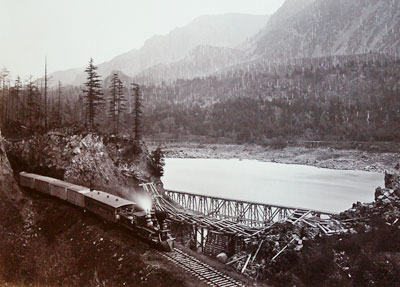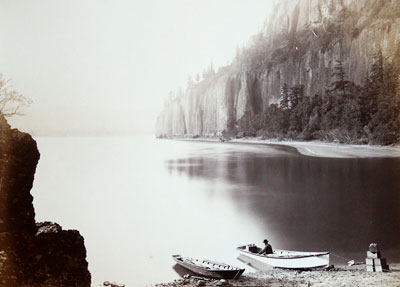The River Corridor
Nature destined the Columbia River Gorge to be a transportation corridor. The imposing Cascade Mountains to the north and south of the river create arduous travel conditions in the best of times.
Native Americans traveled the river in dugout canoes for thousands of years. In fact, the nearby trading village of Celilo on the banks of the river was the oldest continuously inhabited community on the North American continent before it and Celilo Falls were submerged by the construction of The Dalles Dam in 1957.
Euro-Americans began traveling the Gorge in the 1800s when the Lewis and Clark Expedition traversed the area in 1805. The first major movement of Euro-Americans through the Gorge came in the 1840s when pioneers traveling to the Willamette Valley loaded their covered wagons on log rafts near The Dalles for the dangerous float west to the Sandy River where they would resume an overland route.

Carleton Watkins photographed this train at Tooth Bridge on the Columbia River in 1867. (Oregon State Archives, Scenic Image No. PICT14-1)

Carleton Watkins photographed these boats at Cape Horn along the Columbia River in 1867. (Oregon State Archives, Scenic Image No. PICT7-1)
Technology drove the next major transportation advances in the Gorge. Beginning in 1850, steamboats ferried passengers and cargo on both the Willamette and Columbia rivers, reaching The Dalles a year later. Meanwhile, construction of a rough wagon road on the Oregon bank began in 1856. Finally, the railroad extended the reach of technology in the 1880s with the laying of track on the Oregon bank running from Portland to The Dalles.
As often happens with new technology, the growth of the railroad led to the demise of the wagon road and severely diminished the role of river boats in the Gorge. This type of disruptive advance would replay later in the transportation history of the area.
 Steamboats plied the waters of the Columbia River carrying cargo and passengers beginning in the second half of the 1800s. This mural in The Dalles by Robert Thomas and Debbi Lunz shows the Umatilla House hotel on the riverbank and steamboats on the Columbia River at The Dalles. (Oregon State Archives, Scenic Image No. DSC203-3)
Steamboats plied the waters of the Columbia River carrying cargo and passengers beginning in the second half of the 1800s. This mural in The Dalles by Robert Thomas and Debbi Lunz shows the Umatilla House hotel on the riverbank and steamboats on the Columbia River at The Dalles. (Oregon State Archives, Scenic Image No. DSC203-3)
(Source:
Historic American Engineering Record (HAER) No. OR036-N)